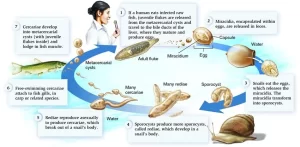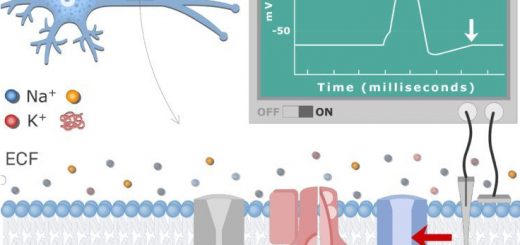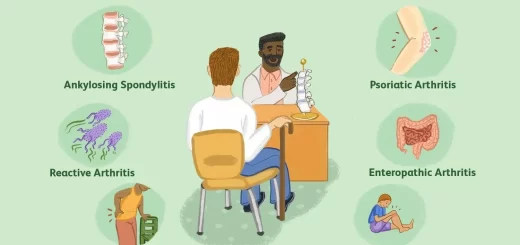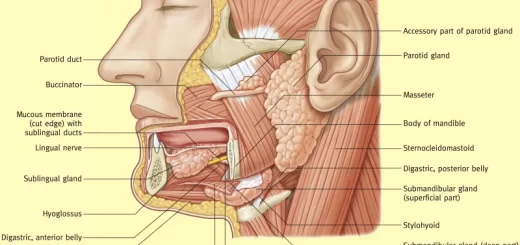Medical helminthology, Flat and Round Worms, Life Cycle of Trematodes, Cestodes and Nematodes
Helminths or parasitic worms are multi-cellular, bilaterally symmetrical elongate, flat, or rounded animals. Helminths that occur as parasites in man belong to two phyla, Phylum Platyhelminthes (Flat Worms), and Phylum Nematoda (Round Worms).
Phylum Platyhelminthes
Platyhelminthes or flatworms are dorsoventrally flattened, leaf-like, or ribbon-likeو Their alimentary tract is rudimentary or completely absent and they have no body cavity. Most of them possess male and female organs (hermaphrodites), This phylum is divided into four classes of which only, Trematoda and Cestoidea include human parasites.
Class Trematoda
Trematodes are commonly known as flukes.
General Morphology
Adults are leaf-like, pear-shaped or elongate worms, covered externally by a cuticle that may be smooth, spiny or tuberculated, All trematodes possess at least two suckers as organs of attachment. The digestive system of a trematode starts by the mouth opening which leads to a pharynx, then a short oesophagus which bifurcates into two long blind intestinal caeca.
Depending on their habitat, they feed on blood, intestinal contents, biliary secretions or tissue juices, Almost all parasitic trematodes are hermaphrodites except bilharzia worms or schistosomes which have separate sexes.
Life Cycle of Trematodes
Flukes are called digenetic trematodes because they undergo two different modes of reproduction: sexual in the definitive host and asexual in the snail intermediate host), Adult trematodes lay eggs that are either operculated or provided with a spine, The eggs may be mature or immature (i.e. may or may not contain a fully developed embryo called miracidium) when freshly evacuated in the host’s excreta.
In water, eggs are either ingested by the snail host or they hatch liberating the miracidia which penetrate their specific snail, In the snail host, the miracidia transform into different larval stages resulting finally in the cercarial stage, A typical cercaria has a body and a tail.
Cercariae eventually leave the snail to water. They swim freely for a few days after which they either penetrate the skin of the definitive host or encyst in a second intermediate host or on water vegetations. Examples of medically important trematodes are Fasciola species, Heterophyes heterophyes, and Schistosoma species.
Class Cestoidea
Cestodes are commonly known as tapeworms.
General Morphology
Adults are flat ribbon-like and segmented, Their length varies from a few millimeters to several meters, The body is divided into a head or scolex, neck, and several segments (proglottids), The chain of proglottids is called strobila, The scolex is provided with suckers as organs for attachment, The neck is the region of growth.
The segments or proglottids are differentiated into immature, mature, and gravid segments, Mature proglottids contain fully developed reproductive organs, The gravid ones are usually at the end of the strobila and contain the uterus filled with eggs.
Cestodes have neither a body cavity nor an alimentary tract. Nutrients are absorbed through their cuticle or tegument which has also a protective function by secreting substances that inactivate the host’s digestive enzymes.
They are hermaphrodites having both male and female reproductive organs in each mature segment, Adults reproduce sexually either by cross-fertilization between different mature segments or through self-fertilization in the same segment.
Life Cycle of Cestodes
Adults are parasites of the small intestine of man or animals. They require one or two intermediate hosts with the exception of Hymenolepis nana which has only one host acting as the intermediate and definitive host, Gravid segments or eggs which contain a hexacanth embryo (possessing six hooks) known as the oncosphere pass in faeces of their definitive hosts, and are considered the diagnostic stage.
In most cestodes, the eggs are mature and passed in the stool, After ingestion of eggs by the intermediate host, the hexacanth embryos are liberated from the eggshell, penetrate the intestinal wall with the aid of the hooks and develop in various organs into cystic larval stages e.g. cysticercus, cysticercoid ar hydatid cysts, When these larval stages are ingested by the definitive hosts, they develop into adults in their small intestines.
In cestodes, the infective stage in humans is either the mature egg or the cystic larval stage, Examples of medically important cestodes are the Taenia species, Hymenolepis nana, and Echinococcus granulosus.
Phylum Nematoda
Members of the phylum Nematoda (Roundworms) are unsegmented, bilaterally symmetrical and elongated with a body cavity and a patent digestive tract, The sexes are separate, and males are always shorter than females.
General Morphology
The nematodes are cylindrical worms, The digestive is a patent tube starting with the mouth opening anteriorly and ending posteriorly by an anus in females and a cloacal opening in males which is the opening resulting from the joining of the male genital system with the digestive system. Nematodes can be classified according to their habitat into intestinal and tissue nematodes.
Life Cycle of Nematodes
In most intestinal nematodes, the eggs are immature when passed into the stools. They need a period of maturation outside the body to become infective to man, The method of infection is by ingestion of contaminated food or by drinking polluted water with mature eggs, Infection may also occur by penetration of the skin by infective larvae.
The diagnostic stage of intestinal nematodes could be egg, larva, and sometimes adult worm in the stool, On the other hand, tissue nematodes require an arthropod vector for transmission of infective larva which is considered the infective stage. They could be diagnosed by the detection of larvae in the blood.
Examples of medically important intestinal nematodes are Trichuris trichiura, Enterobius vermiculans, Ascaris lumbricoides, Ancylostoma duodenale, and Strongyloides stercoralis, Wucherenia Bancrofti is an example of tissue nematode.
You can follow science online on Youtube from this link: Science online
You can download Science online application on google Play from this link: Science online Apps on Google Play
Medical parasitology, Sources of Parasitic Infection, Types of Parasites & Hosts
Importance & types of fungi, Opportunistic infections & Predisposing factors to candidosis
Vaccines types, Live vaccines, Inactivated vaccines, Subunit vaccines, Naked DNA & mRNA vaccines
Adaptive (Acquired immunity) types, Difference between Innate & Adaptive Immune responses
Features and classification of viruses, Defective viruses & Viral vectors used for gene therapy
Cytokines function, use, definition, inflammation & side effects




